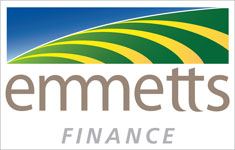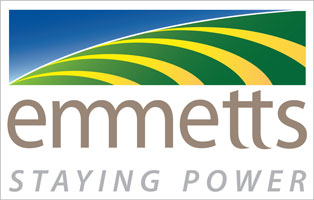
- Naturally aspirated diesel engine
- eHydro™ Transmission
- Open Station
- Premium features: Hitch Assist, Aux Hitch Control, HST controls
Features
Attractive styling provides improved visibility and serviceability
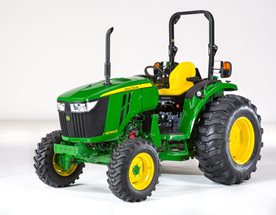 4R Tractor
4R Tractor
The bold styling of the 4M and 4R Tractors provide an attractive and functional appearance similar to that of the larger agricultural tractors. Benefits of this styling include:
- Easy tractor family identification
- Updated fixed grille and side panel hood design allows for optimum sealing of the cooling compartment
- Front grille slides up to an integrated maintenance position for easy battery access
- Easily removable cowl, allowing for serviceability access
- Wraparound-style halogen headlights
- Premium integrated automotive style headlight bezels
- Bold graphics
- Aggressively sloped hood design, giving a softer, smoother look and providing improved visibility
- Hybrid exhaust in base on cab tractors for clear operator visibility and safety
- At low speed and when tractor is in a filter cleaning process, exhaust will be routed through vertical exhaust outlet. In all other cases, the exhaust will be routed through the downward exhaust outlet.
- Side exhaust in base on open operator station tractors and ensures minimal heat impact to operator
The result gives the tractor a distinctive appearance and feel.
NOTE: If the tractor is equipped with an optional field-installed vertical exhaust, exhaust pipe must be removed before opening and closing the hood of the tractor.
Powerful Yanmar® diesel engine delivers plenty of power under heavy loads
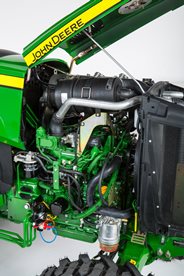 Powerful Yanmar engine
Powerful Yanmar engineThe Yanmar diesel engine has a high-torque reserve that provides plenty of power under heavy load.
This 4-cylinder engine features lower levels of exhaust emissions and reduced noise levels. It meets EPA Final Tier 4 (FT4) emission standards.
Model | Number of cylinders | Engine displacement | Aspiration | Rated rpm | Gross engine hp* | Gross engine ps* | PTO hp |
4044/R | 4 | 2.2 L | Natural | 2600 | 42.5 | 43.1 | 32.5 |
4066M/R | 4 | 2.1 L | Turbocharged | 2600 | 65.0 | 65.9 | 52.0 |
*Engine hp (kW), gross SAE J1995: 43.1 (31.7) at 2600 rpm, PS Displacement, cu in. (L):134.25 (2.2)
*Engine hp (kW), gross SAE J1995: 65.9 (48.5) at 2600 rpm, PS Displacement, cu in. (L):128.15 (2.1)
The engine uses the latest technologies to optimize fuel economy, improve control and accuracy, and reduce environmental impact.
The common rail system (CRS) optimizes fuel economy and reduces operating costs (compared to engines not using CRS technology). High-pressure injection atomizes fuel into finer particles which burn more completely. It results in improved fuel economy and lower cost of operation.
The electronic control unit (ECU) provides optimum fuel control and accuracy. ECU monitors and controls the engine. It continuously monitors engine conditions and adjusts the fuel delivery accordingly to ensure optimum performance and emissions.
The engine comes with an aftertreatment system. The system operates automatically. The exhaust filter consists of a diesel particulate filter (DPF) which captures particulate matter (PM) contained in the exhaust gas. Using a natural cleaning process, most of the PM trapped in the exhaust filter is eliminated by the heat of the exhaust stream generated by normal use. In situations of low temperature, engine speed or load factor, an active cleaning cycle is initiated. In this cleaning cycle, the exhaust gas temperature is raised by injecting additional fuel during the exhaust stroke of normal vehicle operation to the diesel oxidation catalyst (DOC).
After many hours of use, the exhaust filter may require an ash removal service.
DPF cleaning
Depending on the load that the tractor is under, as well as ambient temperature, humidity, and engine speed, the DPF may build up with particulate matter, thus requiring cleaning. Filter cleaning is determined by one of three conditions:
- A prescribed time-based estimation of needed filter cleaning
- DOC/DPF pressure sensors
- A particulate matter buildup estimation based on load conditions
Once one of the three conditions has been met, filter cleaning will occur.
There are three different types of filter cleaning processes:
- Passive filter cleaning
- Active filter cleaning
- Parked filter cleaning
Passive filter cleaning
Passive filter cleaning occurs naturally when the engine is generating enough heat to oxidize particulate matter. This automatic process occurs continuously during normal operating conditions. No tractor icons or symbols appear on the display during passive filter cleaning.
NOTE: Passive filter cleaning requires no operator involvement, and there is no interruption to tractor operation.
Active filter cleaning
If conditions (temperature, load, or speed) for passive filter cleaning cannot be achieved, then PM is removed using active filter cleaner.
To achieve the required conditions, exhaust temperature management (ETM) manages the initiation and duration of active filter cleaning. ETM can adjust numerous engine parameters and/or inject a small quantity of fuel into the exhaust stream for a short duration. The fuel turns to vapor and chemically reacts with the catalysts in the DOC to create heat to oxidize PM.
It is important to note that at no time is the fuel in the DOC/DPF ignited, and there is no flame within the DOC/DPF.
Like passive filter cleaning, active filter cleaning requires no operator involvement, and there is no interruption to tractor operation.
Parked filter cleaning
In some instances where passive and active filter cleaning have not fully cleaned the PM from the system, a parked filter cleaning may need to take place. Most likely, the only time a parked filter cleaning will need to occur is when automatic filter cleaning has been disabled for an extended period of time and multiple warnings to engage filter cleaning were ignored or if the tractor has been used during light load conditions. Additionally, when the automatic filter cleaning process has been deliberately interrupted multiple times, or if active filter cleaning has failed numerous times due to a failed component, a parked filter cleaning may be requested. In these rare instances the operator will have to park the tractor and start the filter cleaning process.
The parked filter cleaning process needs to be activated based on usage and operation of the tractor. The process will take approximately 30 minutes. See operator’s manual for more details.
This system constantly monitors the soot level of the tractor, making sure the tractor is always in peak performance condition. This ensures high performance at all times.
NOTE: Number of hours since last regeneration and soot level percentage viewable on LCD display.
Key features of the engine are:
- Lower rated speed for 540 rpm power take-off (PTO) operation means better fuel economy, less noise and vibration, and longer overall engine life
- Cast-in-block cylinder design for good cooling and long life
- Hydraulic lifters are quieter and require no adjustment
- Heavy-duty crankshaft provides more bearing surface area for added durability
- CRS optimizes fuel economy, lowering the cost of operation
- ECU provides optimum control and accuracy
- Direct fuel injection
- Improves starting
- Injects fuel directly on top of pistons for more efficient combustion
- Develops more horsepower per gallon of fuel
- Glow plugs (cold starting aid)
- Engine oil cooler, cools engine oil for longer engine life
- Key start and shutoff eliminates fuel shutoff knob
- Electric solenoid shuts fuel supply off immediately when key is turned off
- See-through coolant recovery tank permits operator to check coolant level without removing radiator cap
- Sealed radiator compartment keeps trash and debris on outside of hood
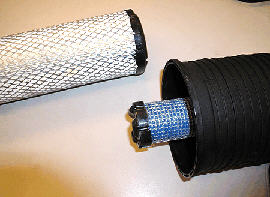 Dry-type air cleaner
Dry-type air cleaner
- Dry-type air cleaner with safety element and electronic air service indicator
- Electronic air restriction indicator alerts operator when air filter servicing is required
- Dual-element design for added engine protection
- Easy to service
- Standard side exhaust
- Upward exhaust standard on turbo-charged Snow Cabs
- Optinal vertical exhaust kit
Yanmar is a trademark of Yanmar Company Limited.
Maximize productivity with an eHydro™ transmission
The tractor comes with a three-range electronic hydrostatic (eHydro) transmission.
- Fluid under pressure transmits engine power to the drive wheels using a pump and motor
- Functions both as a clutch and transmission
- Provides high torque for startup
- Reduces powertrain shock loads
Danfoss® supplies both the pump and motor. This ensures that the components are matched to each other, providing maximum efficiency.
The electronic hydrostatic transmission is ideally suited for jobs where productivity is a must, such as loader or mower applications.
Twin Touch™ foot controls allow the operator to select both directions of travel and speed with a touch of the toe.
Key features of the eHydro transmission:
- Infinitely variable ground speeds, in each range, allow the operator to match the speed of the tractor to the job.
- No clutching means fast and easy direction changes.
- Twin Touch foot pedals provide quick and easy forward/reverse operation.
- Cruise control is standard equipment:
- Cruise control switch is located on the right-hand console for easy access.
- Cruise control is electronically engaged and disengaged, which allows for precise setting of speed.
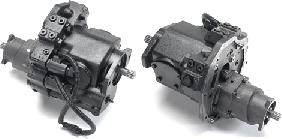 Danfoss eHydro transmission
Danfoss eHydro transmissionDanfoss eHydro transmission is used for reliable operation. Durability features include:
Large forged trunnion shaft with larger support bearings that reduce vibration and noise
Center section made from ductile iron (much stronger than grey iron used in many competitive transmissions)
Transmission oil cooler cools transmission oil for longer transmission life
Safety features of the eHydro transmission include:
The tractor starts with one or both foot pedals depressed, but it does not move until both pedals first return to neutral.
Operator presence system means the tractor comes to a stop if the operator leaves the seat but does not shut off unless the power take-off (PTO) is also running.
Key John Deere advantage
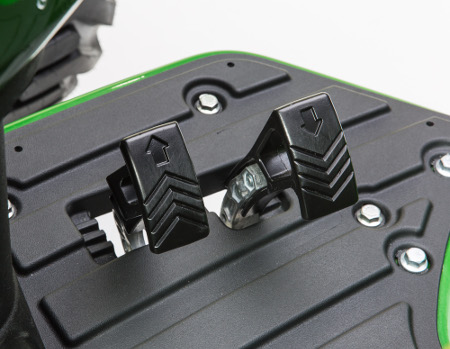 Twin Touch foot controls
Twin Touch foot controlsJohn Deere's Twin Touch foot controls offer key advantages over competitive hydro model tractors.
- Some competitive hydrostatic tractors use a treadle pedal designed (toe-heel) foot control for operation of the hydro.
- Requires the operator to use both toe and heel to change direction, resulting in increased operator fatigue
Integrated eHydro features
The eHydro convenience controls have been integrated into a single module. Combining features such as SpeedMatch™ LoadMatch™, MotionMatch, eThrottle, and automotive-style cruise control pulls the maximum efficiency out of the eHydro transmission tractors. All these features are standard on the 4M Heavy Duty and 4R models and deliver an easier and more comfortable experience.
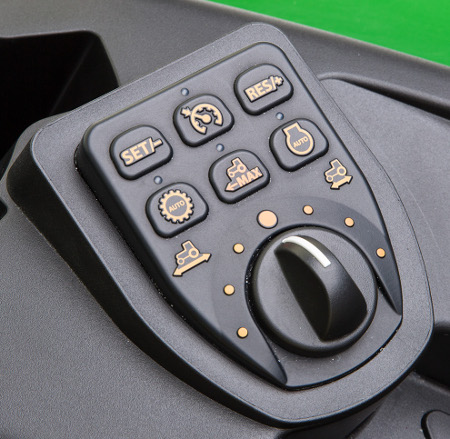 eHydro convenience control module
eHydro convenience control module
| Press button to active/deactivate eThrottle. When eThrottle is activated, depression of the travel pedal increases engine rpm and tractor speed. |
| Press button to active/deactivate LoadMatch. When LoadMatch is activated, engine will not stall during heavy load applications. |
| Press button to activate/deactivate SpeedMatch. When SpeedMatch is activated, operator is able to set the desired maximum travel speed. |
| Press button to activate/deactivate cruise control. When cruise control is activated, operator is able to set cruise speed. |
| Press button to set cruise speed, or to decrease cruise/set max speed. |
| Press button to resume set cruise speed, or to increase cruise/set max speed. |
| MotionMatch - longer accelerate and decelerate distances. |
| MotionMatch - shorter accelerate and decelerate distances. |
eThrottle
 eThrottle indicator
eThrottle indicatorPress a button to activate/deactivate eThrottle. When eThrottle is activated, depression of the travel pedal increases engine rpm and tractor speed simultaneously. This provides the operator with comfort and convenience as well as fuel economy.
Automotive-style cruise control
 Cruise control indicator
Cruise control indicatorAn automotive-style cruise control is standard equipment on the 4M Heavy-Duty and 4R Series Tractors. Cruise control is electronically engaged and disengaged and is located on the right-hand operator console.
- Maintains desired forward speed without pressure on the foot pedal
- When activated, the operator is able to set cruise speed:
- Use the SET/- button to set cruise speed, or to decrease cruise/maximum speed
- Use the RES/+ button to set cruise speed, or to increase cruise/maximum speed
- A speed sensor also allows the tractor to maintain preset speed driving up and down hills
- To disengage the cruise control, either:
- Apply pressure to the brakes
- Disengage cruise control button
- Briefly depress the reverse travel pedal
LoadMatch power management system
 LoadMatch indicator
LoadMatch indicatorLoadMatch is a standard feature on the 4M Heavy-Duty and 4R Series Tractors.
If torque requirements increase significantly, the transmission reduces the tractor's drive speed to compensate for the increased load on the transmission, maximizing torque to drive wheels and minimizing stalls.
Controls automatically adjust LoadMatch compensation depending on the tractor’s application. PTO applications require less engine speed fluctuation, therefore adjusting the amount of droop depending on PTO speed. This adjustment increases efficiency and optimizes engine speed and torque output based on tractor application.
While typically left on, LoadMatch can be turned off with the right-hand console controls.
MotionMatch
MotionMatch, standard on the 4M Heavy-Duty and 4R Series Tractors, is located on the right-hand console. It offers seven settings for adjusting the rollout or decelerating when the pedal is released.
 MotionMatch indicator
MotionMatch indicatorThis icon indicates longer accelerate and decelerate distances.
 MotionMatch indicator
MotionMatch indicatorThis icon indicates shorter accelerate and decelerate distances.
SpeedMatch
 SpeedMatch indicator
SpeedMatch indicatorSpeedMatch, standard on the 4M Heavy-Duty and 4R Series Tractors, further enhances the eHydro cruise control functions by allowing the operator to preset maximum speed. Once this feature is engaged, the operator must stroke the travel pedal fully to meet the operator’s preset speed and press the Set button to lock the speed. From there, the operator can use the automotive-style cruise controls to adjust speed. This function will improve accuracy and safety, particularly at lower travel speed applications.
Rotary tilling or spraying applications are examples of where SpeedMatch can be applied. SpeedMatch will work in both the forward and reverse set speeds.
NOTE: Automotive-style cruise control and SpeedMatch can be used in conjunction with LoadMatch to maximize productivity.
Danfoss is a trademark of Danfoss A/S Corporation.
Operator station is comfortable and convenient
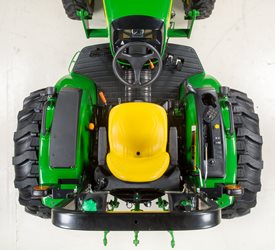 Easy entry and exit from the operator's station
Easy entry and exit from the operator's station
The operator's station is designed for easy entry and exit from the tractor.
Conveniently placed brake pedals, as well as repositioned operator controls, provide for a clean and flat platform design, giving the operator plenty of legroom.
- Hood and fenders are made from composite polymer material designed to eliminate the possibility of rusting and resistant to dents that can occur with metal hoods and fenders. This material provides a high-luster appearance with excellent resilience and resistance to fading from sunlight.
- Easy-fold rollover protective structure (ROPS), with built-in, rattle-reducing, tension rod.
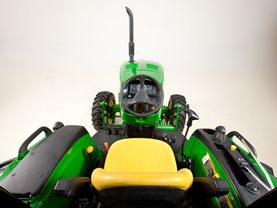 Comfortable and convenient design
Comfortable and convenient design
Key features of the operator's station include:
- Large grab handles on each fender to make getting on and off the tractor easy
- Foot platform that is rubber mounted and incorporates a rubber mat for operator comfort
- Center console and fender toolboxes that provide ample storage
- Large cup holder on right-hand fender
- Fender-mounted forward work lights (two lights)
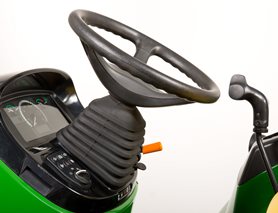 Adjustable, tilt steering wheel
Adjustable, tilt steering wheel
- Improved tilt steering wheel design is in base equipment. The tilt wheel:
- Allows the operator to adjust the steering wheel to the most comfortable position
- Provides additional clearance for the operator to enter and exit the tractor
- Provides easy return to fully raised position
- Provides plenty of room for comfortable operation
- Controls are shape and color-coded for easier identification and operation
- 12-V outlet is standard on the 4R Tractors and provides power for mobile devices
- Integrated junction block provides switched and unswitched power to add additional accessories
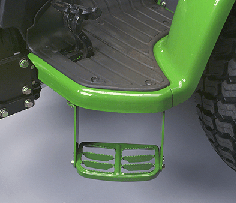 Left-side step
Left-side step
- A left-side step is in base equipment to enhance access to the operator's station
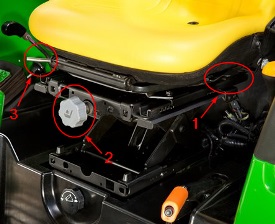 Adjustable scissor-type suspension seat
Adjustable scissor-type suspension seat
- Swivel seat adjustment (1) with armrests is in base equipment on all 4R open station tractors to decrease operator fatigue when operating rear-driven implements. The seat swivels 15 degrees in either direction. It also provides convenience and comfort while entering and exiting the tractor.
- An air suspension seat is optional for the 4R Series Tractors.
- Air suspension is not compatible with the swivel function.
- An air suspension seat is optional for the 4R Series Tractors.
- The scissor-type suspension seat gives the operator a comfortable ride. The seat flips forward for protection from the elements.
- Seat suspension is adjustable for the operator's weight and height.
- Operator weight adjustment (2) adjusts to the operator’s weight (52.2 kg to 124.7 kg [115 lb to 275 lb]).
- The seat is adjustable fore and aft for the operator’s height using the lever (3) located under the seat.
- Retractable seat belts prevent belts from becoming tangled in seat suspension and controls.
Hitch assist and auxiliary 3-point hitch control for easy implement hookup
Hitch assist (ground positioning)
The hitch assist feature allows the operator to creep the tractor backward or forward while standing behind the tractor. Engaging and operation includes the following steps:
- Ensure hitch assist switch is in off position (A below)
- Engage the park brake
- Select A range
- Set to low throttle
- Ensure power take-off (PTO) is off
- Operator must be in the tractor’s seat
- Activate the hitch assist switch
- If successful, flashers will trigger
- If not, the missing interlock will be displayed on the LCD screen
- Once flashers are triggered, if the operator leaves the seat, the display will beep indicating that the hitch assist is in remote mode
- Operator moves to back of the tractor, start motion of the tractor using the enable button (B below) and corresponding direction button (C below)
- Push and hold both buttons continuously as long as motion is desired
- Audible alarm will sound indicating motion of the tractor
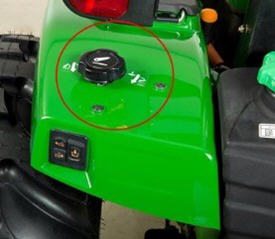 Auxiliary 3-point hitch control (open station tractor)
Auxiliary 3-point hitch control (open station tractor)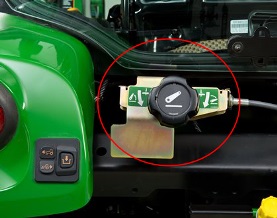 Auxiliary 3-point hitch control
Auxiliary 3-point hitch control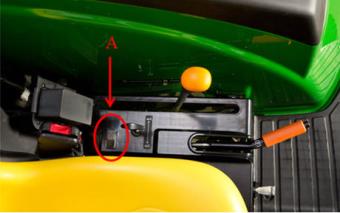 Hitch assist switch
Hitch assist switch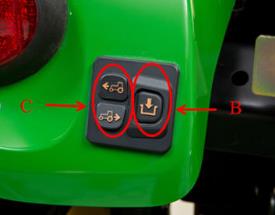 Enable and directional buttons
Enable and directional buttonsAuxiliary 3-point hitch control
The auxiliary 3-point hitch control on the left-hand fender allows the operator to raise or lower the hitch while standing on the ground behind the tractor.
Pairing the auxiliary 3-point hitch control with hitch assist, changing implements has never been easier. Both features are in base equipment for 4R Series eHydro™ transmission models.
Save fuel, reduce noise, and increase engine life with the economy power take-off (PTO)
The optional field-installed 540/540 economy power take-off (PTO) allows operators to select the engine rpm needed for their PTO application. The economy position provides 540 rpm to the PTO at approximately 70 percent of the engine's normal rated speed. The engine runs at a rated speed of approximately 1750 rpm in the 540 economy position. The 540 economy is ideal for any PTO application, from running a mower to a baler or a cutter, where full horsepower is not needed. Operating at lower engine rpm decreases fuel costs during tasks. The overall operating experience improves because there is less noise and vibration for the operator.
A conveniently located lever (behind the seat of the tractor) allows the operator to simply change between 540 and 540E when conditions merit the opportunity to save fuel without affecting performance. For heavy-duty operations that require maximum PTO power, the PTO shift lever is placed in the 540 position, the PTO engaged, and the engine is run at rated speed of 2400 rpm. This selection gives 540 rpm to the PTO shaft and delivers the full-advertised horsepower at rated engine speed.
The 540/540 economy PTO offers all the features of the standard 540-rpm PTO, and the safety interlock is a foolproof measure provided to compensate for operator oversight. When the tractor is in economy, the engine is limited to a lower operating speed, preventing accidental over speeding of PTO implements and protecting against binding the PTO shaft. The safety interlock also prevents accidental shifting of the PTO selector lever at higher engine speeds than the economy PTO setting, which would lead to downtime to fix implements or drivetrains. Please note that economy PTO is only applicable to 4066R.
Excellent serviceability reduces operational costs and improves productivity
Regular service and maintenance are essential to the performance, productivity, and longevity of the tractor.
- Easy access to regular service points minimizes service time.
- Easily removable cowl and side panels, improved hood design, and integrated maintenance position on the grille provide easy accessibility for routine maintenance.
- Tractors are equipped with extensive onboard self-diagnostic capabilities and are fully compatible with exclusive John Deere Service ADVISOR™ system.
- Daily service requirements are minimal and simple to accomplish. Most service interval requirements can be performed with a basic understanding of procedures and common tools.
- Improved cost of ownership
- Hydraulic oil service interval changed from 400 to 1200 hours (or 3 years) when using Hy-Gard™ products
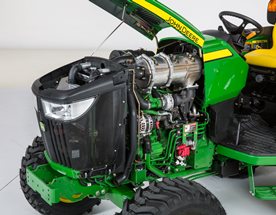 Removable side panels
Removable side panels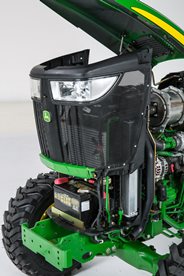 Integrated grille maintenance position
Integrated grille maintenance position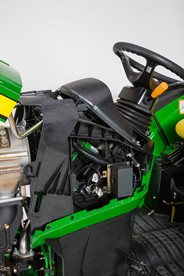 Removable cowl
Removable cowlAll items in the daily service schedule can be performed without the use of tools:
- Engine oil, hydraulic oil, coolant level, and the water separator can be conveniently accessed
- The engine can be easily accessed by simply raising the hood for more periodic maintenance checks
- A single-point latch mechanism and self-contained leash ensure easy hood opening and closure
NOTE: Always refer to the operator’s manual for complete maintenance and service recommendations.
Specifications
Key Specs
- Engine power (gross)
- 31.7 kW
43.1 hp
PS at 2600 rpm
SAE J1995 rated power
- Power take-off (PTO) power
- PRT - 25 kW
33.6 hp
eHST - 24.1 kW
32.3 hp
Per SAE J1995
- Steering hydraulics
- 23.5 L/min
6.2 gpm
- Implement hydraulics
- 42.3 L/min
11.2 gpm
- Hitch type
- Category 1
- Lift capacity, 24-in. behind link arms
- 1135 kg
2500 lb
- Standard transmission; forward/reverse
- eHydro Transmission (eHST)
- Cruise control
- Standard
- Approximate shipping weight (open-station; cab)
- OOS - 1710 kg
3770 lb
Cab - 2120 kg
4675 lb
- Wheelbase
- 185.5 cm
73 in.
Engine
- Family
- EYDXL2.19NDA
FYDXL2.19NDA
GYDXL2.19NDA
- Manufacturer
- Yanmar
- Engine model
- 4TNV88C-MJT
- Engine power (gross)
- 31.7 kW
43.1 hp
PS at 2600 rpm
SAE J1995 rated power
- Power take-off (PTO) power
- PRT - 25 kW
33.6 hp
eHST - 24.1 kW
32.3 hp
SAE J1995
- Rated engine speed
- 2600 rpm
- Type
- Diesel
- Injection pump type
- High pressure common rail direct injection
- Aspiration
- Natural
- Emissions compliance
- Final Tier 4
- Cylinders/displacement
- 4 / 2.189 L
4 / 133.5 cu in.
- Number of cylinders
- Four
- Cylinder liners
- Cast-in-block
- Bore and stroke
- 88x90 mm
3.46x3.54 in.
- Compression ratio
- 19.1:1
- Lubrication
- Pressurized
- Cooling system
- Liquid
- Air cleaner
- Dual element with electronic restriction indicator
- Engine torque at rated speed
- 116 Nm
85.6 lb-ft
- Fuel tank capacity
- Rollover protective structure (ROPS) - 56.9 L
15 U.S. gal.
Cab - 52.2 L
13.8 U.S. gal.
Electrical
- Battery size
- 770 CCA
- Alternator (12-V)
- 75 amp
- Starter size
- 2 kW
2.68 hp
Fuel System
- Type
- High pressure common rail direct injection
- Fuel consumption
Transmission
- Standard transmission; forward/reverse
- eHydro transmission (eHST)
- Optional transmission; forward/reverse
- 12/12 PowrReverser transmission (PRT)
- Left-hand reverser
- PRT only
- Transmission gear ranges
- PRT - 12F/12R
eHydro - Infinitely-variable, 3 range
- Final drive
- Planetary
- Brakes
- Multi-plate wet disc
- Steering
- Hydrostatic power steering
- Clutch, wet/dry
- Wet
- Clutch disk diameter wet clutch
- 129 mm
5.08 in.
- Axle capacity
- Front
1600 kg
3528 lb
Rear
2400 kg
5292 lb
- Creeper
- SpeedMatch standard
- Cruise control
- Standard
- Differential lock
- Yes
- Drawbar maximum vertical load
Hydraulics
- Type
- Open center
- Pump rated output
- Steering
23.5 L/min
6.2 gpm
Implement
42.3 L/min
11.2 gpm
65.8 L/min
17.4 gpm
- Pump type
- Single gear
- Maximum operating pressure
- Draft control sensing
- Position control
- Remote control valves available
- Up to six rear remotes
3 Point Hitch
- Type
- Category 1
- Lift capacity, 24-in. behind link arms
- 1135 kg
2500 lb
Power Take Off (Pto)
- Standard
- Independent
540 rpm at 2600 rpm
- Optional
- 540E rpm
- Control
- Position
- Clutch
- Wet disc
- Brake (for mid and rear PTO)
- Engagement method
Fluid Capacities
- Crankcase with filter
- 5.3 L
1.4 qt
- Transmission and hydraulic system
- 47.3 L
12.5 gal.
Final Drive
- Type
- Planetary
- Differential lock
- Yes
Operator Station
- Rollover protective structure
- Type
Foldable
Yes
- Platform - flat/straddle
- Flat
- Gear shift location - console/floor
- PRT - Left-hand side
Cab
- Compliance
- OSHA, SAE, ASAE
- Visibility
- 360 degree (angle)
- Air conditioning, temperature differential
- 14.4 °C
58 °F
- Doors
- Two
- Noise rating
- 78 dBA
- Seat equipment
- Air suspension with swivel
Dimensions
- Height
- Wheelbase
- 185.5 cm
73 in.
- Front axle clearance
- 35.1 cm
13.8 in.
- Turning radius with brakes
- 2.8 m
9.17 ft
- Turning radius without brakes
- 3 m
9.84 ft
- Limited slip differential
- Approximate shipping weight (open-station; cab)
- OOS - 1710 kg
3770 lb
Cab - 2120 kg
4675 lb
Tires
- Front
- Farm - 8-16
Turf - 27x10.5-15 or 27x12LL-15
Industrial - 10-16.5
- Rear
- Farm - 13.6-28
Turf - 44x18-20 or 22.5LL-16.1
Industrial - 16.9Lx24
- Front tread range
- 148.1 cm
58.3 in.
- Rear tread spacing
- 137.2 cm
54 in.
Miscellaneous
- Toolbox
- Tilt steering wheel
- 12-V Outlet









